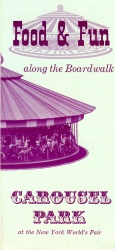| |
|
|
Greer
Marechal (age 40) and I (age 19), and incidentally B.W. who was
carousel Park's manager, all lived in Greenwich Village (New York
City) in the early 60's. Greer was a patent attorney. His brother,
Kelsey Marechal, owned the Limelight Restaurant on 7th Avenue and it
was there that he met Marshall Bates, a sort
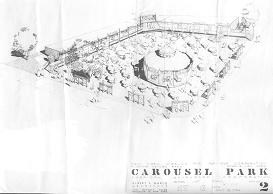 of
odd fellow who I think was a friend of John Rogers. Bates was
interested in getting money to get the Carousel moved from Coney
Island to the Fair. By the time this started the Fair was pretty much
underway--in planning anyway. There had been an original deal I think
with S&H Green stamps to sponsor the carousel, but it had fallen
through by the time we got involved. Moses had an idea about the
Amusement area based on his negative memories of the same area in the
'39 Fair--too tawdry, honky-tonk, etc. So he wanted a "family" fun
place. Needless to say this disappointed many of the investors in the
amusement area because they wanted nightlife and the money it
creates. Also, for some odd reason the specific geography of the
amusement area was not originally planned as exclusive to
amusements. Thus it was that the site the carousel eventually landed
on was originally the "American Indian Pavilion", which had already
gone bankrupt but which had laid pilings for their building's
foundation (the pilings were necessary because the whole area was
landfill from '39). The carousel was placed on those pilings, reducing
our cost considerably. of
odd fellow who I think was a friend of John Rogers. Bates was
interested in getting money to get the Carousel moved from Coney
Island to the Fair. By the time this started the Fair was pretty much
underway--in planning anyway. There had been an original deal I think
with S&H Green stamps to sponsor the carousel, but it had fallen
through by the time we got involved. Moses had an idea about the
Amusement area based on his negative memories of the same area in the
'39 Fair--too tawdry, honky-tonk, etc. So he wanted a "family" fun
place. Needless to say this disappointed many of the investors in the
amusement area because they wanted nightlife and the money it
creates. Also, for some odd reason the specific geography of the
amusement area was not originally planned as exclusive to
amusements. Thus it was that the site the carousel eventually landed
on was originally the "American Indian Pavilion", which had already
gone bankrupt but which had laid pilings for their building's
foundation (the pilings were necessary because the whole area was
landfill from '39). The carousel was placed on those pilings, reducing
our cost considerably. |
| |
|
|
 |
 |
|
Early Feltman |
Early Stubman |
| |
|
|
If my
memory is correct, the Feltman had already been dismantled and in a
warehouse. The Stubman may have been inoperative but still standing. 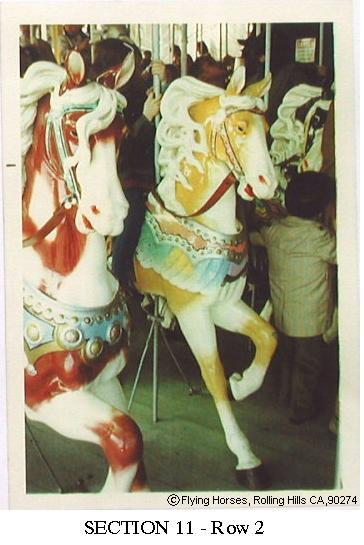 The
deal that Rogers presented to us was that we would buy both (which I
believed he had on option on, but did not own outright), use the
horses from the Feltman (and maybe the organ) and then use the
Stubman's works and platform. I'm a bit vague on whom all the
principals of American Cavalcade Corp were, but I think it was Greer,
John, Kelsey, and Greer's accountant Walter Neville. It was
immediately clear, however, that selling 15 cent rides on a carousel
would never recoup the investment of moving Feltman's to the
site. Also, the Feltman works were pretty much shot. However, the
horses were magnificent--although in pretty rough shape. Hence the
solution to put the Feltman horses on the Stubman works. I believe
the chariots were from the Stubman. The horses were restored by a
truly wonderful artist who lovingly painted them in a warehouse. You
can notice however, that they did not have carved tails. Instead they
were supposed to have real horse's tails, so we ordered tails but the
horses arrived at the fair without them. When the tails finally
arrived a few weeks after the start of the operation, we discovered
that they had not been cured! They were rotting, and reeked! We spread
them on the roof of the bandshell in the hopes of letting them
completely dry out. The carousel operated without tails for the
complete first season. Also, the horses' internal lights were not
restored since the Stubman platform did not have the requisite
electrical connections. The
deal that Rogers presented to us was that we would buy both (which I
believed he had on option on, but did not own outright), use the
horses from the Feltman (and maybe the organ) and then use the
Stubman's works and platform. I'm a bit vague on whom all the
principals of American Cavalcade Corp were, but I think it was Greer,
John, Kelsey, and Greer's accountant Walter Neville. It was
immediately clear, however, that selling 15 cent rides on a carousel
would never recoup the investment of moving Feltman's to the
site. Also, the Feltman works were pretty much shot. However, the
horses were magnificent--although in pretty rough shape. Hence the
solution to put the Feltman horses on the Stubman works. I believe
the chariots were from the Stubman. The horses were restored by a
truly wonderful artist who lovingly painted them in a warehouse. You
can notice however, that they did not have carved tails. Instead they
were supposed to have real horse's tails, so we ordered tails but the
horses arrived at the fair without them. When the tails finally
arrived a few weeks after the start of the operation, we discovered
that they had not been cured! They were rotting, and reeked! We spread
them on the roof of the bandshell in the hopes of letting them
completely dry out. The carousel operated without tails for the
complete first season. Also, the horses' internal lights were not
restored since the Stubman platform did not have the requisite
electrical connections. |
| |
|
|
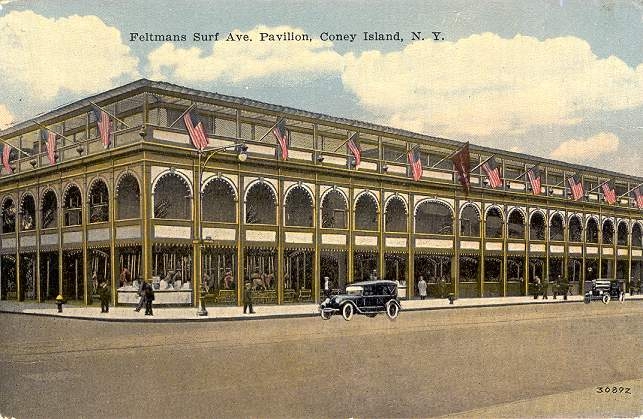 |
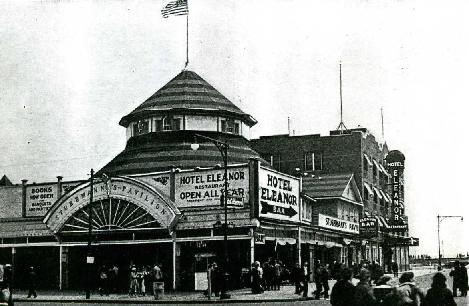 |
|
The Feltman
pavilion at Coney Island |
The Stubman pavilin at Coney Island |
| |
|
The Carousel Park idea arose in order to address the question of
finances. Moses allowed us to build the "boardwalk" with its
concession stands, even though there was a Brass Rail concession directly across the street, which had some
sort of "no competition" clause in its lease. This however, didn't
bother Moses who genuinely wanted the Carousel there and could
understand the impossibility of financing it on 15 cent rides. So the
boardwalk was born and that was what got Vinny Mastro involved. He had
some sort of pavilion on the main fairgrounds and wanted a presence in
the amusement area (but had been stopped by Brass Rail's exclusive
lease). Also, he had invented a device which speeded up the rising of
pizza dough--oddly called a "retarder"--which he was eager to
showcase. His primary business was in selling restaurant
equipment. (He went on to found Verrazano College, somewhere upstate
NY, which I believe was eventually bought by Colgate College.)
American Carousel Corporation was the owner of the boardwalk and
leased the stands to different concessionaires. It also ran a few
itself (I think the hamburger stand was theirs). American Carousel
Corporation, I believe, leased the carousel from American Cavalcade
Corp, which continued to own it as well as the remains of the
Stubman. Principals of American Carousel were Greer, Kelsey, Mastro,
and again perhaps Walter Neville. Most of the money was Greer's, but
Kelsey also put up some capital. Mastro's investment I believe was
limited to his own concession stand.
was a Brass Rail concession directly across the street, which had some
sort of "no competition" clause in its lease. This however, didn't
bother Moses who genuinely wanted the Carousel there and could
understand the impossibility of financing it on 15 cent rides. So the
boardwalk was born and that was what got Vinny Mastro involved. He had
some sort of pavilion on the main fairgrounds and wanted a presence in
the amusement area (but had been stopped by Brass Rail's exclusive
lease). Also, he had invented a device which speeded up the rising of
pizza dough--oddly called a "retarder"--which he was eager to
showcase. His primary business was in selling restaurant
equipment. (He went on to found Verrazano College, somewhere upstate
NY, which I believe was eventually bought by Colgate College.)
American Carousel Corporation was the owner of the boardwalk and
leased the stands to different concessionaires. It also ran a few
itself (I think the hamburger stand was theirs). American Carousel
Corporation, I believe, leased the carousel from American Cavalcade
Corp, which continued to own it as well as the remains of the
Stubman. Principals of American Carousel were Greer, Kelsey, Mastro,
and again perhaps Walter Neville. Most of the money was Greer's, but
Kelsey also put up some capital. Mastro's investment I believe was
limited to his own concession stand. |
| |
|
|
I don't
believe that anybody except Rogers had any idea of what they were
getting into with the two carousels. Greer and Kelsey saw it as an
opportunity to "get in on" the Fair, which had not yet begun to
generate the many stories about bankruptcy that would be its future
legacy. Moses’ supposed recollection of the carousel was most
probably hype. I think he visited it once in the two years, and that
was to inaugurate a ramp built at right angles to the overpass over
the LIE to allow fairgoers to visit Carousel Park without passing the
Brass Rail visible. This was done some time in late July of the first
season.
|
|
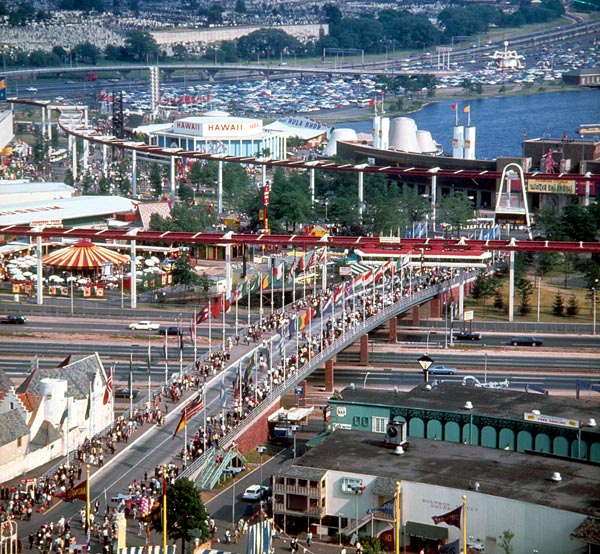
Perpendicular ramp present in the center of the photo
leadng from the bridhe to carousel Park (1965) |
| |
|
|
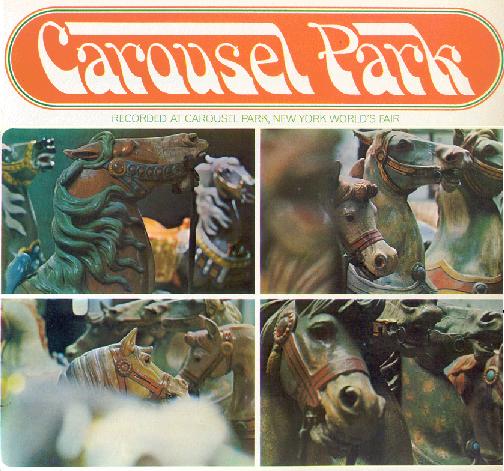 (The
Organ) was a very complicated story as I recall. The Feltman one did
not work but was gorgeous. The Stubman one worked but was pedestrian
looking. I believe we put both in the new hybrid and consequently came
into possession of about 40 rolls of carousel music delivered in a
crumbling cardboard carton. Many of these were torn, and some
completely unplayable. We had someone working on keeping the organ
going practically night and day. The toys on the Feltman might have
worked initially, but I'm pretty sure that we did not keep them
in operation. And we very seriously considered tape recordings. I
believe the impetus behind recording the carousel was the potential of
playing tapes without having to keep the organ going. I'm not sure
who (The
Organ) was a very complicated story as I recall. The Feltman one did
not work but was gorgeous. The Stubman one worked but was pedestrian
looking. I believe we put both in the new hybrid and consequently came
into possession of about 40 rolls of carousel music delivered in a
crumbling cardboard carton. Many of these were torn, and some
completely unplayable. We had someone working on keeping the organ
going practically night and day. The toys on the Feltman might have
worked initially, but I'm pretty sure that we did not keep them
in operation. And we very seriously considered tape recordings. I
believe the impetus behind recording the carousel was the potential of
playing tapes without having to keep the organ going. I'm not sure
who
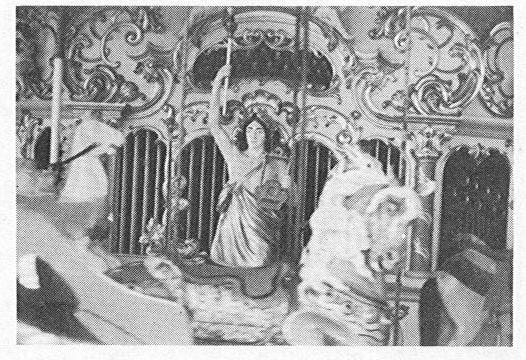 did
the restoration on the works of the organ but I remember that he had
been familiar with it from Coney Island. Of the 50 or so rolls only
about 10-12 were in playable condition, and some of those had been
pieced together with masking tape so that the songs were pretty
jumpy. Eventually we played probably only 5 or 6, which the customers
didn't seem to notice but which drove the employees crazy since they
had to listen to them for shifts up to 12 hours at a time! The
recording was done at night after the Fair closed in order to minimize
ambient noise (especially the traffic on the LIE but also the crowds
at the part and other amusement rides). Many of the recorded songs
were patched together in post production since the rolls would fall
apart as they were being played. We did look into buying new rolls of
music but it was prohibitively expensive, having to be done by hand
because of the odd number of stops, etc. I think the estimate was over
$1000 per roll, which since everyone was now losing (should I say
hemorrhaging?) money, was out of the question. I still have a least
one of the recordings. did
the restoration on the works of the organ but I remember that he had
been familiar with it from Coney Island. Of the 50 or so rolls only
about 10-12 were in playable condition, and some of those had been
pieced together with masking tape so that the songs were pretty
jumpy. Eventually we played probably only 5 or 6, which the customers
didn't seem to notice but which drove the employees crazy since they
had to listen to them for shifts up to 12 hours at a time! The
recording was done at night after the Fair closed in order to minimize
ambient noise (especially the traffic on the LIE but also the crowds
at the part and other amusement rides). Many of the recorded songs
were patched together in post production since the rolls would fall
apart as they were being played. We did look into buying new rolls of
music but it was prohibitively expensive, having to be done by hand
because of the odd number of stops, etc. I think the estimate was over
$1000 per roll, which since everyone was now losing (should I say
hemorrhaging?) money, was out of the question. I still have a least
one of the recordings. |
| |
|
|
Moses
knew almost from the first that he wanted the carousel to remain at
Flushing Meadow so we pretty much had an assured buyer for the
Feldman/Stubman hybrid from the beginning; although we did list it for
sale because the city was slow in approving it. Where they would put
it was another matter but eventually he persuaded the city to buy it
and it was moved to it's current location across the LIE. The remains
of the Stubman horses (which were also from Ilion's shop although not
at all as beautiful, remained in a warehouse until after Greer's death
in 1968. I believe the estate then sold them for somewhere about $100
apiece!. Most of the pictures on the cover of the album are of stubman
horses in the warehouse which accounts for their "artsy" poses and dim
lighting.
|
|
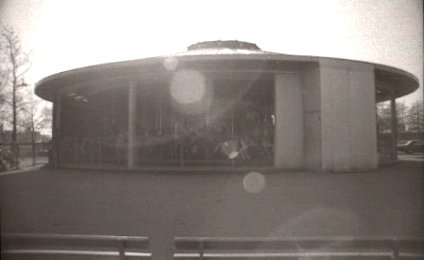
The carousel in the 1980's |

Example of horses that didn't make it to the final
carpusel, they were sold through a catalog in the 1970's |
| |
|
|
The
whole experience was pretty much a nightmare. Everyone lost lots of
money almost immediately. Moses had caved into the building unions to
avoid a strike on opening day. Their contract required them to work
only at night after the Fair
 was
closed (after midnight for the Amusement Area)--thus everything was
double time. To change one light bulb on the carousel cost $80. You
can see how many incandescent bulbs we had to deal with. The whole
thing got darker and darker over the summer until it was practically
under 1/3 of it's intended illumination. The brass ring device had
been installed, but it was never used as this was considered too
dangerous by the insurance company. We were able to keep the organ
worker on contract because the union couldn't handle the job. But
round and round it turned for almost the complete first season and all
of the second. I loved the horses, especially the ones with the
portrait of Illions and his wife carved into the saddle. I think,
however, the lion was the most sought after mount. I have only seen
the carousel once since, about 4 years ago, and was not impressed with
how it looks. CP's restoration, as you can see from the pictures, was
really magnificent. Regrettably I have lost the pictures I took of the
horses once they were completely refurbished (can't remember the name
of the artist who did this, but he was a genius, even replacing
several of the "jewels" in the saddles and bridles. I will ask B.W.,
who is one of the few people directly involved who is still living). was
closed (after midnight for the Amusement Area)--thus everything was
double time. To change one light bulb on the carousel cost $80. You
can see how many incandescent bulbs we had to deal with. The whole
thing got darker and darker over the summer until it was practically
under 1/3 of it's intended illumination. The brass ring device had
been installed, but it was never used as this was considered too
dangerous by the insurance company. We were able to keep the organ
worker on contract because the union couldn't handle the job. But
round and round it turned for almost the complete first season and all
of the second. I loved the horses, especially the ones with the
portrait of Illions and his wife carved into the saddle. I think,
however, the lion was the most sought after mount. I have only seen
the carousel once since, about 4 years ago, and was not impressed with
how it looks. CP's restoration, as you can see from the pictures, was
really magnificent. Regrettably I have lost the pictures I took of the
horses once they were completely refurbished (can't remember the name
of the artist who did this, but he was a genius, even replacing
several of the "jewels" in the saddles and bridles. I will ask B.W.,
who is one of the few people directly involved who is still living).
|
| |
|
 |
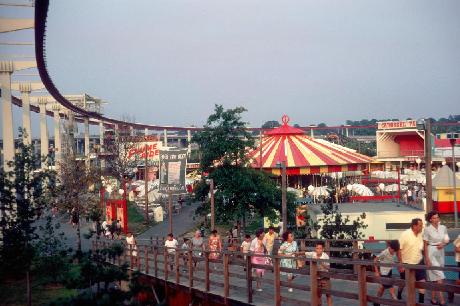 |
|
Carousel Park 1964 |
Carousel Park 1965 |
| |
|
|
Many thanks to Mr. Edward Dunne for taking the time to put his story
into written word. We will update the story when possible. |
|
| |
|
| |
|
|
ALL pictures and content Copyright 2011 (c) M. Silverstein and those
original owners who donated material for this website. |
| |
|
|
BACK TO HOME PAGE |
BACK TO THEN
AND NOW |
|
| |
|
